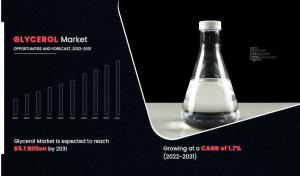Why Glycerol's Future Looks Bright and What’s Fueling Its Rise
The glycerol market, estimated at $4.3 billion in 2021, is projected to grow steadily, reaching $5.1 billion by 2031. This growth is driven by the increased adoption of natural products and a rise in biodiesel production, which boosts the glycerol supply chain. However, fluctuating raw material prices pose challenges. Key players like Emery Oleochemicals and Kao Corporation are at the forefront, navigating these dynamics. Europe currently holds a significant market share, with Asia-Pacific expected to grow fastest due to high demand in pharmaceuticals and personal care.
Breaking News
Jul 22, 2025
News Desk

Let's dive a little deeper into the exciting world of glycerol. It's not every day you see a market projected to hit $5.1 billion in the next decade, right? But that's exactly what's happening with glycerol, driven by its adoption across multiple industries and regions. Now, why is this particularly happening? Well, it seems like the surge in natural product demand, coupled with an increase in biodiesel manufacturing, is really giving the glycerol market a much-needed boost. But let's not get ahead of ourselves; there are headwinds like fluctuating raw material prices that need to be considered.
Interestingly, the heavyweights in the industry—think of names like Emery Oleochemicals and Procter & Gamble Chemicals—are constantly navigating these challenges. It's a balancing act, really, trying to capitalize on the growth opportunities while keeping costs in check. And speaking of opportunities, isn't it fascinating how emerging economies are stepping up as key players? They're anticipated to create lucrative investment pockets, especially in sectors like personal care and food & beverages.
European markets seem to be a cornerstone for glycerol right now, holding a dominant market share. Yet, if you were to take a peek into the future, Asia-Pacific is where the real action is expected to be. This region isn't just sitting idly by; it's growing rapidly, thanks to its burgeoning pharmaceutical and personal care sectors. Plus, there's a massive consumer base for food products that can't be overlooked.
The market dynamics are even more interesting when you zoom in on specific segments. For instance, biodiesel and refined glycerol are leading the charge. Biodiesel, which makes up a sizeable part of the market now, is expected to continue its reign due to its importance as a biofuel by-product. Meanwhile, refined glycerol holds a commanding share and is poised for growth in areas like pharmaceuticals, personal care, and food.
But, let's not forget the flipside. Challenges like fluctuating raw material costs don't make life any easier for this industry. Companies in this space have to be on their toes, constantly monitoring market conditions and adjusting their strategies accordingly. I mean, who likes unpredictability, right? But, it seems that's just part of the game!
Looking forward, I think we'll see more innovation in the glycerol market. Companies may invest in more efficient production processes to cut costs and improve sustainability. And let's not rule out the role of policy changes or technological advancements, which could further shape market trends.
In summary, the glycerol market is riding a wave of growth underpinned by significant industry drivers. Although challenges exist, especially in terms of raw material pricing, the future looks cautiously optimistic for those ready to adapt and seize new opportunities. It's a dynamic landscape, and keeping an eye on it could provide valuable insights into broader market trends.
